What are the “intangibles” that can elevate your routine to the top? Every optional gymnastics routine is evaluated, at the end, on several general categories. These categories can result in general deductions for the routine, if there are deficits in these areas. Most routines receive a deduction in at least one of these areas. But what are the categories, and what can a gymnast do to avoid these deductions?
Let’s find out.
What are general deductions?
General deductions in gymnastics are a set of deductions that are applied at the end of the routine. These deductions are taken “overall”, or in relation to the entire routine. They do not apply just to one skill.
Often, a judge will make notes on their paper throughout the routine, to determine if a general deduction should be taken. An example would be rhythm deductions. Let’s say that the gymnast pauses frequently during her beam routine, and the routine does not flow smoothly. The judge might note an “R” on their paper each time the gymnast’s rhythm is poor. Then, the judge would deduct at the end of the routine based on how many “R”s were written down.
List of General Deductions
The general deductions that can be taken during an optional routine are as follows:
- Dynamics
- Rhythm
- Artistry
- Posture/Flexibility
- Footwork
- Sureness
Now, let’s take a closer look at each of these categories.
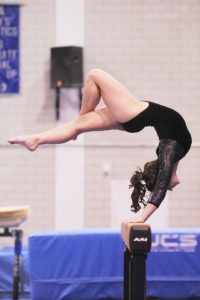
Dynamics
The deduction for insufficient dynamics is up to 0.20. When I am judging, I will write a small “D” on my paper if the gymnast has areas of the routine that look sluggish. The dynamics deduction can be taken on every event. (Vault is not discussed in this article, but the dynamics deduction is higher there, up to 0.30.)
Dynamics on Bars
On bars, there are three components of the dynamics deduction. These components are: 1) insufficient swingful execution; 2) energy not maintained; 3) fails to make difficult look effortless.
Swingful execution? What does that mean? When I look at a bar routine, the gymnast’s swing should look natural and easy. If she labors to get over the top in a giant swing, performs jerky-looking kips, or needs to segment her body to increase her swinging amplitude, this could lead to a dynamics deduction.
Similarly, sometimes the gymnast seems to fizzle out toward the end of the routine. The final skills look tired and slow. Sometimes a person watching might wonder if she’s going to make it through. That’s a dead giveaway that she could get a deduction for dynamics.
Finally, the difficult skills should look easy. If the gymnast has a lot of errors during her hardest skills, she will, of course, get deducted for those errors. But if the mistakes make the tough skills look like they’re too hard for her, a dynamics deduction is possible as well.
Dynamics on Beam and Floor
Dynamics deductions also apply on beam and floor. The latter two categories from above are considered when the judge decides whether to take a dynamics deduction.
On beam and floor, the routine should look crisp and clean. The gymnast should show energy and spark throughout the routine. Here are some examples of dynamics problems: gymnast is looking down a lot, does not fully extend in her positions, looks sluggish or tired. Just like on bars, the gymnast should maintain this energy until the completion of the routine. Sometimes, the last tumbling pass looks labored, or the gymnast’s momentum seems to “die out” toward the end. In those instances, she could incur a dynamics deduction.
Rhythm
The official definition of a rhythm deduction is “insufficient variation in rhythm and tempo throughout the exercise”. This deduction is up to 0.20 for the routine. The key word here is “variation”. A routine with good rhythm will have portions that move more slowly, and portions that move quickly. The gymnast should transition between slow and fast movements smoothly. Awkward starts and stops could cause the gymnast to get a rhythm deduction.
Additionally, a gymnast should keep her routine moving, without pauses or stops between skills or choreography segments. Concentration pauses of 2 seconds or longer are a separate deduction, but smaller pauses would fit under the general rhythm category.
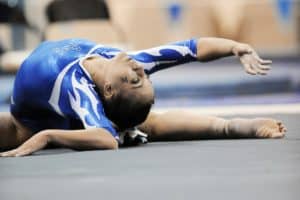
Artistry
Artistry describes the gymnast’s ability to present her routine to the audience and judges. There are three components to artistry, each worth 0.10, for a total possible deduction of 0.30. Straight from the Code, they are: “originality/creativity of choreography, quality of movement to reflect personal style, and quality of expression (i.e. projection, focus)”.
The first component, originality and creativity of the choreography, is pretty straightforward. The gymnast should do something creative in her routine, whether it is a series of poses, a flexibility move, a unique skill, or an entire theme in the choreography. The gymnast should make the judges and crowd sit up and say, “Wow, that was cool!”
Second, the quality of movement should reflect the gymnast’s personal style. This means that a gymnast with a more balletic style should use music that enhances this style, rather than a loud, bouncy piece. The choreography should match the music, and it should be something that the gymnast can do well.
Finally, quality of expression should be displayed throughout the routine. To do this, the gymnast should engage with the audience as she performs her routine. Eye contact, using the entire body in her choreography, and changing facial expression are some ways to show expression.
In my experience, the artistry deduction is used much more on floor than on beam, but it is still possible to get an artistry deduction on beam. A gymnast who looks down at the beam the entire time, half-heartedly performs her poses, and has nothing even slightly original in the routine could receive this deduction.
Take a look at this article for more detail on how to demonstrate artistry in gymnastics.
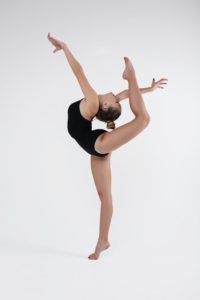
Posture/Flexibility
The deduction for poor posture and flexibility is up to 0.30. This deduction includes leg position, body posture, and poor flexibility in non-value parts throughout the routine. Non-value parts is another way of saying choreography and connections. It describes parts of the routine that are not considered skills in the Code of Points. This deduction applies to these non-skill movements.
Poor leg position could include small knee bends, leg separations when legs are supposed to be together
Body posture describes the way a gymnast stands and moves during her choreography and dance connections. Each time I notice a problem with posture during a routine, I write a small “P” on my paper. These problems can include head forward or sticking out, ribs out, bottom sticking out, arched back, or a forward lean that does not seem choreographed. Sometimes some of these positions can be choreographed into the routine, which isn’t always a problem. It’s best to make sure any poses with choreographed bad posture or flexed feet are VERY obvious, so the judge understands it’s supposed to be that way.
Insufficient flexibility can be deducted in a variety of ways. First, if the gymnast performs kicks that are low and lacking in amplitude, this deduction applies. Also, if a non-value part split is performed, such as on floor, a full 180° split is expected. When the gymnast performs a split that is not flat on the floor, a deduction in this category can be taken. Choreography pieces such as straddle rolls on the floor should also show a full split in order to avoid deductions.
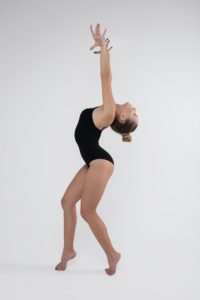
Footwork
The deduction for relaxed or improper footwork is up to 0.20. The footwork deduction applies to beam and floor routines. Examples of poor footwork include flexed feet, sickled feet, and steps not performed in high releve. Any time a foot leaves the floor, it should be pointed. Make sure the entire foot is pointed, not just the toes. When the gymnast takes a step, she should step through a pointed foot, and step into high releve. Some judges, especially those with a dance background, are very tough on footwork. Great footwork can really change the entire look of a routine. It will give the routine a polished appearance and set the gymnast apart from her competitors.
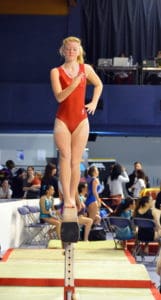
Sureness
Sureness is a general deduction of up to 0.20. It applies only to balance beam routines. We’ve all seen the beam routine where the gymnast looks terrified. Or the gymnast who is shaking so badly that she looks like she could fall at any time. These are examples of routines that would incur a sureness deduction.
The ideal beam routine would be performed in high releve throughout the routine. The routine should be performed confidently, and the gymnast should appear sure of herself. This deduction ties in with artistry, because if the gymnast appears unsure of herself, she will also likely get an artistry deduction.
What About Composition?
Composition deductions are separate from general deductions, although both types of deductions apply to the routine as a whole. Composition deductions relate to the difficulty of the skills the gymnast performs, rather than the manner in which she performs the routine. A gymnast might get a composition deduction if her difficulty is not up to the expected level. For more information on composition, take a look at these composition articles: Level 8 beam, Level 9 beam, and Level 10 beam. Floor composition is discussed in this series: Level 8 floor, Level 9 floor, and Level 10 floor.
Further Reading
Want to learn more about general deductions and categories? Check out these articles:
How to Demonstrate Artistry in Gymnastics
General Categories for Exemplary Compulsories
References: USA Gymnastics J.O. Code of Points, 2018-2022
